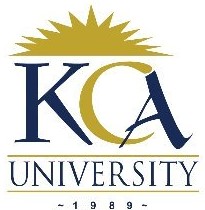
UNIVERSITY EXAMINATIONS: 2013/2014
ORDINARY EXAMINATION FOR THE BACHELOR OF SCIENCE
IN INFORMATION TECHNOLOGY/BUSINESS INFORMATION
TECHNOLOGY
BIT 2103 BBIT 200 PRINCIPLES OF ARTIFICIAL INTELLIGENCE
DATE: AUGUST, 2014 TIME: 2 HOURS
INSTRUCTIONS: Answer Question ONE and any other TWO
QUESTION ONE
a) Briefly explain ‘Turing Test’ in the context of artificial intelligence (3 Marks)
b) Consider the following search problem of 8-puzzle game (4 Marks)

Define the search problem in terms of states, operators, a goal test and a path cost.
c) Describe the meaning of the following terms in the context of artificial intelligence
i) Artificial intelligence (2 Marks)
ii) Heuristics (2 Marks)
iii) Proposition (2 Marks)
d) Briefly explain any three applications of expert systems (3 Marks)
e) State and explain any three branches of artificial intelligence
f) Describe five properties of a good Knowledge Representation technique. (5 Marks)
g) Suppose the truth value of Y is True and that of X is False. Use a truth table to
determine the truth value the following expression. (3 Marks)
(~Y X) ˄Y .
h). Represent the following sentences in predicate logic
i) Peter loves ann (2 Marks)
i) Everything is lovely (2 Marks)
ii) all animals eat. (2 Marks)
QUESTION TWO
a) Distinguish between ‘informed’ and ‘blind search’ strategies. Give one advantage and
disadvantage for each category. (4 Marks)
b) Consider the search tree below

(Assuming E is the Goal node, show at each step what nodes are in the queue for both
the. Breath-First-Search and Depth-First-Search. (6 Marks)
c) Describe five characteristics of a good search technique. (5 Marks)
d) State and explain the meaning of the term ‘semantic network’ in the context of
artificial intelligence. Draw a well labelled diagram for illustration. ( 2Marks)
e) Briefly explain the meaning of the term bodily-kinesthetic intelligence. Give one
technique that can be used to improve it and one potential career for people with that
type of intelligence. (3 Marks)
QUESTION THREE
a) Consider the following map (not drawn to scale).
i) Use the A* algorithm to work out a route from town A to town M. Use the
following cost functions. (8 Marks)

G(n) = The cost of each move as the distance between each town (shown on map).
H(n) = The Straight Line Distance between any town and town M. These
distances are given in the table below.
Assume the estimated costs by the heuristic were replaced and shown in the following
table

ii) Provide the search tree for your solution, showing the order in which the nodes
were expanded and the cost at each node. You should not re-visit a town that you
have just come from. (2 Marks)
iii) State the route you would take and the cost of that route. (2 Marks)
c) Write about 400 words on ‘expert systems’ topic under the following headings.
(8 Marks)
i) Definitions and explanation of key terms
ii) Why they are considered intelligent
iii) Current applications
iv) Components
QUESTION FOUR
a)Briefly explain the meaning of the following terms and give one example for each
case
i) Intelligent agent (3 Marks)
ii) Actuator (3 Marks)
b) Distinguish the following types of agents’ environments (4 Marks)
i) Accessible vs. inaccessible Environment
ii) Episodic vs. non-episodic Enviroment
c) State and explain any 3 properties of an intelligent agent (3 Marks)
d) Briefly describe 3 differences between intelligent agent and normal software
(3 Marks)
e) State and explain any four types of intelligent agents (4 Marks)
QUESTION FIVE
a). define the following terms
i) Inference (2 Marks)
ii) Animatronic systems. (2 Marks)
iii) Robot (2 Marks)
b). State and explain five parts of a robot (5 Marks)
c). State and explain three common kinds of sensors that are used by robots (6 Marks)
d). Describe three characteristics of a robot (3 Marks)
